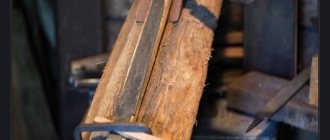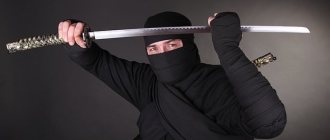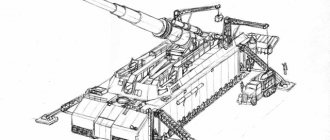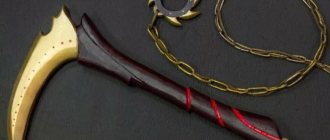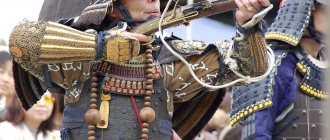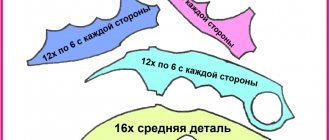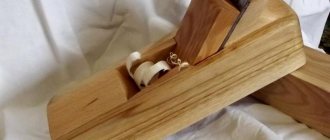The tanto knife is a traditional edged weapon in Japan, intended for self-defense, close combat, cutting off the enemy’s head, and finishing off the enemy. The length of the blade should not exceed 303 mm, the handle must be removable and attached to the blade using a bamboo pin. The blade is made of sponge steel.
Modern tanto knives are used only in the imperial family and to replenish the collections of people who are passionate about edged weapons. There is a more popular option - the American tanto, which has worse quality characteristics.
History of the tanto knife
Tanto is a knife that belongs to the category of short-bladed weapons and is included in the set of basic weapons of the Japanese samurai. If you classify a knife according to the European system, then it is classified as a standard dagger, but in Japan, experts are sure that it is an ordinary sword, but slightly shortened.
The Japanese do not pronounce the name of the knife the same way Europeans do. They say “tan that”, which means “short sword”.
Historically, the tanto knife was intended for Japanese warriors to fight. The first mention of this type of bladed weapon dates back to 800-1200 years, when knives were made of low-quality steel and were quite rough. Further, until 1868, there was a peak in the production and popularity of tantos, they became a real work of art, and the most “expensive” master for making such knives was Yoshimutsu - he made weapons for samurai.
After 1868, the demand for the tanto began to decline, and as a result, the presence of a knife of this type remained only as a tribute to tradition. During World War II, active production of weapons began again to supply the Japanese army.
In 1950, a law was passed in the Land of the Rising Sun, according to which the tanto knife became the historical, cultural property of the people; it had to be protected from destruction. The only caveat: the weapons that were produced in 1940-1945 were subject to destruction due to the poor quality of the metal.
After the 50s, the history of the Japanese tanto knife “stopped”, but found its continuation in... America. It was this country that began mass production of the American version of Japanese edged weapons in the 80s of the last century.
We recommend reading the article about throwing knives. From it you will learn about the types and forms of throwing knives, where you can throw knives, and how to make a throwing knife yourself. And here is more information about how to make a knife from a file.
Odachi
In addition to the above types of long sword, there were less known and widespread ones. One of these is odachi. The term is often confused with nodachi, which is described below, but these are two different swords.
Literally, odachi translates as “big sword.” Indeed, the length of its blade exceeds 90.9 cm. However, there is no exact definition, which is also observed with other species. In fact, every sword exceeding the above value can be called an odachi. The length is about 1.6 m, although it often exceeds it; the hilt of the Japanese sword was considerable.
Swords have not been used since the Osaka-Natsuno-Jin War of 1615. After it, a special law was issued prohibiting the use of bladed weapons of a certain length. Unfortunately, only a tiny amount of odachi survives today. The reason for this is that the owners cut off their own bladed weapons in order to comply with the standards. After the ban, swords were used as gifts, as they were quite valuable. This became their purpose. The high cost was explained by the fact that manufacturing was extremely complex.
Why do you need a tanto sword?
Previously, the tanto sword was needed only for combat; it was not used at all for household needs. Rarely did samurai choose such weapons to perform the hara-kiri ritual, not only by men, but also by women and children. There are known cases when, during hostilities, hara-kiri became families for themselves.
The tanto sword had different shapes over the years, and this influenced its use. For example, a triangular blade made it possible to pierce the enemy’s armor with one blow, and a knife with a special hook provided an advantage in close combat - they could intercept the enemy’s weapon and snatch it out of his hands.
Most often such weapons were used for:
- cutting off heads;
- fighting in close quarters;
- finishing off a wounded enemy;
- self-defense (used by monks, traders and those who were forced to make long journeys).
Modern tanto knives are part of Japanese culture; they are part of the collection of edged weapons and are considered part of the wedding ceremony for members of the imperial family. Martial arts schools also use such blades for training and gaining close combat skills, but only as wooden dummies.
Hashiwara and jutte
Specific stilettos for fighting armed samurai. Hashiwara is a purely combat weapon, it was supposed to pierce the opponent’s armor, and the hook was used to repel the enemy’s sword.
Jutte is a more humanized police weapon. Since it was extremely undesirable to kill samurai gentlemen, and it was useful to restore order, the hashiwara became a cylindrical rod with a more developed hook at the end.
Technical characteristics of a Japanese tanto knife: blade, blade, shape, dimensions
The Japanese tanto knife has individual sizes and shapes, it has a characteristic blade, and the entire blade is easily recognizable.
| Characteristics of a Japanese knife | Short description |
| Blade shape | Flat with slightly curved tip |
| Blade length | 303 mm (standard), can start from 170 mm (souvenir option) |
| Blade thickness | 5-7 mm |
| Total tanto length | 350-500 mm |
| Blade material | Sponge steel |
| Handle type | Removable |
| Handle mounting type | Bamboo pin |
| Garda | Present, removable and round |
Modern examples of the Japanese tanto knife have worse characteristics. For example, they have a straight bevel of the butt of 45 degrees, which reduces the penetrating properties of the weapon; the blade is made absolutely straight, without a narrowed nose, which impairs cutting ability. At the same time, the strength of the tip of the short sword blade remains at a high level, so it is always possible to stick it into something hard.
Nodachi
The name literally means field sword. Nodachi, like odachi, had enormous length. Because of her, creation was difficult. The sword was worn on the back, since this was the only way possible. Nodachi did not become widespread precisely due to the complexity of its manufacture. In addition, it also required skill when fighting. The complex handling technique was due to its large size and enormous weight. It was almost impossible to snatch a sword from behind your back in the heat of battle. But where then was it used?
Perhaps the best use was fighting horsemen. The large length and sharp end made it possible to use the nodachi as a spear, which could hit both humans and horses. The sword was also quite effective when dealing damage to several targets at once. But nodachi is completely unsuitable for close combat. Samurai, if necessary, threw away the sword and picked up a more convenient katana or tachi.
American tanto: differences
The American tanto became the first knife that was widely advertised and became more widespread than its Japanese “ancestor”.
Differences between guns made in the USA:
- the tip of the blade is strongly bent upward, which makes the knife look like an ordinary kitchen tool;
- the blade has a stiffening rib, and the bevel is made straight at an angle of 45 degrees;
- sharpening can be one-sided, but more often double-sided is used;
- blade length ranges from 100-300 mm;
- the total length of the knife can be 220 mm, but does not exceed 500 mm;
- a wide variety of steel can be used in production, including Damascus;
- the guard may be completely absent or flat in shape;
- the handle is not removable.
American tanto
From the point of view of Japanese masters, samurai, American tanto is a real mockery of the cultural heritage of their country. But well-made advertising by the first manufacturer of such weapons, Lin Thompson, and aggressive marketing did their job - the Americans believed that such a knife was the sharpest and had an almost eternal service life.
Tati
The long Japanese sword, which was replaced by the katana, was quite popular at one time. The fundamental differences between them could be identified even at the stage of creating the blade - a different design was used. Katana has much better performance, but tachi also deserves attention. It was customary to carry a long sword with the blade down; it was secured to the belt with a special bandage. The scabbard was most often wrapped to prevent damage. If the katana was part of civilian clothing, then the tati was exclusively military. Paired with it was the tanto sword. Also, tachi was often used as a ceremonial weapon at various events and in the courts of shoguns and emperors (the former can also be called princes).
When compared with the same katana, the blade of the tachi is more curved and also longer, about 75 cm. The katana is straight and relatively short. The handle of the tachi, like the sword itself, is quite strongly curved, which is the main distinguishing aspect.
Tati also had a second name - daito. In Europe it is usually pronounced "daikatana". Error due to incorrect reading of hieroglyphs.
Useful video
Watch the video on how to make a tanto knife:
Similar articles
- File knife: what steel is it made from, how to make it...
How to make your own knife from a file. What kind of steel will it be made of that will be durable? How to properly harden a knife and release it. How to make a metal knife, a dagger without forging, a finca, a tanto, a kitchen or a pig splitter. How to make a bevel on a knife from a file. How to make a weapon from a rasp. Read more - Combat knife: characteristics, types of special forces knives...
What criteria are used to determine a combat knife? What are the main types, sharpenings, blades? What combat knives are used by Russian, Austrian, American, and Japanese special forces. What beautiful combat knives there are, the best in the world. Which ones are used by airborne, assault, blades. Read more
- Pchak: characteristics, what it is intended for, type...
What are the characteristics of a pchak knife, what type and size it is. What is an Uzbek knife made of Damascus steel used for? What is a gulband, what sheath is needed for a pchak. How to make a knife yourself. Why are knives from Bakhrom Yusupov so valuable? Read more
- Throwing knives: what are the sizes, types...
The best throwing knives for both experienced athletes and beginners. Which ones come in size, type, steel. What should the target and sheath be like? Where can you throw knives? Types of throwing. How much does a good throwing knife cost? Read more
- Santoku knife: type, shape, what it is needed for, what to cut with it...
What are the characteristics of a Santoku knife, what type and shape it has. Why do you need a universal knife, what can you cut with it? What is the difference between a santoku and a chef's knife? What is the price for sets or one knife, which manufacturers produce them. Read more
Interesting points
In Europe and Russia it is believed that the katana is a long sword, but this is not entirely true. It really has been like this for a long time, but its use is a matter of taste. Interestingly, in Japan, the use of daisho was strictly enforced only by samurai. Military leaders and shoguns sacredly revered this rule and issued corresponding decrees. The samurai themselves treated weapons with special reverence; they kept them close to them even while sleeping. The long sword was removed at the entrance to the house, and the short sword was always with you.
Other classes of society did not have the right to use daisho, but could take them individually. A bunch of swords was the main part of a samurai's costume. It was she who confirmed the class affiliation. From an early age, warriors were taught to take care of their master's weapons.
Manufacturing
Like any Japanese sword, the katana has a complex design. The manufacturing process may take several months, but the result is a real work of art. First, pieces of steel placed together are filled with a solution of clay and water, and also sprinkled with ash. This is necessary so that the slag that is formed during the smelting process is absorbed. After the steel is hot, the pieces are joined.
Then the most difficult process begins - forging. The pieces are repeatedly flattened and folded, thereby allowing the carbon to be evenly distributed throughout the workpiece. If you fold it 10 times, you get 1024 layers. And this is not the limit. Why is this necessary? In order for the hardness of the blade to be the same. If there are significant differences, then under conditions of heavy loads there is a high probability of breaking. Forging lasts several days, during which time the layers reach a truly large number. The structure of the blade is created by the composition of the metal strips. This is its original appearance; later it will become part of the sword.
To avoid oxidation, the same layer of clay is applied. Then hardening begins. The sword is heated to a certain temperature, which depends on the type of metal. After this, instant cooling occurs. The cutting edge becomes hard. Then the final work is carried out: sharpening, polishing. The master carefully works on the blade for a long time. Finally, when the edges are flat, he works with small stones held with one or two fingers, some use planks. Today, engraving has become popular, which usually depicts scenes with Buddhist themes. Work is done on the handle, which takes a few more days, and the katana is ready. This Japanese sword is dangerous. The name can be attributed to a large number of representatives that differ from each other.
Instead of an afterword
Throughout the history of mankind, a knife has remained primarily a convenient, functional item for everyday life, war, hunting and survival. Its shape and technology have been improved to achieve maximum comfort and durability. As for the tanto knife, its main task is to be sold. Therefore, in its history, mainly marketing tools were developed to promote this miracle to the American market. Of course, it can be purchased as a souvenir blade, but as a knife for any practical use it is an extremely dubious idea.
And a little more about the American tanto knife:
Daisho
The name literally translates as “big-small”. This is the main weapon of the samurai. The long sword is called daito. Its length is about 66 cm. A short Japanese sword (dagger) is a shoto (33-66 cm), which serves as a secondary weapon for a samurai. But it is a mistake to believe that these are the names of certain swords. Throughout history, the bundle has changed, different types have been used. For example, before the early Muromachi period, the tachi was used as a long sword. Then it was replaced by the katana, which was worn in a sheath secured with a ribbon. If a dagger (short sword) tanto was used with tachi, then wakizashi - Japanese swords, photos of which can be seen below, were usually taken with it.
The Legend of the Blacksmith Amakuni
Another legend concerns the appearance of the katana itself. According to legends, once upon a time, namely around the year 700, the blacksmith Amakuni lived in the province of Yamato, and with him his family. Standing outside his workshop, instead of working in it, he watched the soldiers of the imperial army.
And then the brightest man passed by them, but for some reason he did not say a word in favor of the weapons created by the blacksmiths
Then Amakuni drew attention to the warriors’ weapons. It turned out that many swords could not withstand the heat of the battle and were broken
After this, it became clear why the emperor did not want to talk to the blacksmith. However, he, apparently, was very humane, because for such a blacksmith could say goodbye to his head.
Like a true master, Amakuni decided to improve and make a weapon that would be very difficult to break. He, first of all, took those blades that survived the battle and began to carefully examine them. He found out that many of the intact swords had high-quality material and hardening. After all this, he and his son prayed to the Shinto gods for seven days.
But only then did they come to their senses and decide to work. And after 15 days of persistent trial and error, the blacksmiths appeared with strange swords with a curved shape and a sharp edge on one side. Then everyone thought that Amakuni had gone crazy. But spring came, and with it another war. And so the emperor, when returning from the battle, exclaimed towards the blacksmith: “Amakuni, you are a real master in making swords. Not a single sword of yours was broken in this battle."
This is the legend that the blacksmiths from the Yamato province will tell you. Probably every prefecture will tell this legend, but in their version, Amakuni will live here.
